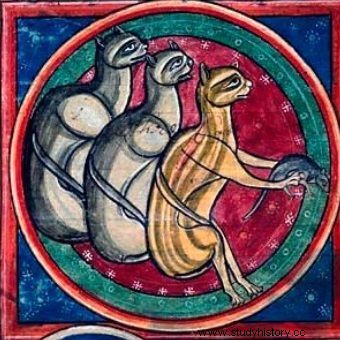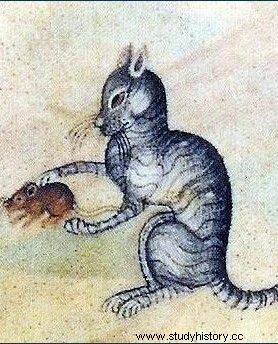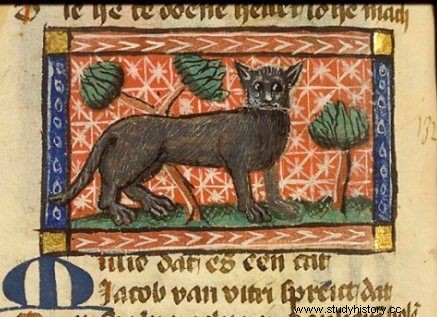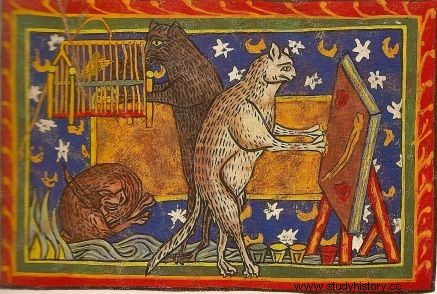Two months ago our text about whether cats were eaten in the past made a sensation. We couldn't leave 14,000 readers alone - it's about time for Part Two. This time we will ask:were cats dressed in the past?
The well-known saying about "a cat in a poke" seems quite peculiar. Of course, everyone can explain what we understand by it today - do not buy goods that you will not see, do not be deceived by paying for something blind. Okay, but how does this relate to cats? Will an uglier cat catch mice less? Or maybe the cat's fur will tell you if it will fawn and pee where necessary? Well, not necessarily. For this I guess the basic question - hell, why would someone keep a cat in a poke and sell it in this way ?! Not only is it absurd, but the poor animal could suffocate. 
Everything becomes clear only when we take into account what the cats used to be "used for", especially the stray ones. They were suitable not only for dinner, but also… for clothes.
In the Middle Ages, the cat had a hard time
Historical sources clearly show that in Western Europe there was a whole "cat industry" :special catchers found and caught cats, furriers removed their skin and made clothes from it, and traders visited fairs and markets, offering goods from the cat. The market for cat clothes was so large that special regulations were introduced regarding the trade in cats.

A medieval cat caught mice one day, and the next day it was a fashionable hat.
For example, in Saint-Vaast in Arras, at the beginning of the 11th century, two ducats of tax were paid on the skin of cats. In Montpellier around 1201 the rules were already more detailed:2 ducats for ready-made cat skins and clothes, but for a dozen cats not yet processed - a ducat. You could also pay a tax on a barrel of cats in the amount of two ducats . Business must have been going really fast if the port of Ipswich in 1303 established a duty not on one cat or a dozen, but on a thousand skins.
Cats could be carried on the back, but probably more often ended up in less affluent homes. Laurence Bobis writes in the book "Kot. History and legends ”that cat skins were often used in interior decoration as rugs, carpets, they were used to upholster chairs and sew covers for pillows. Also in terms of clothes, everyone could find something for themselves:a cat vest, a hat, a lining, a coat, gloves, or a cat cape.
The cat and the criminal underworld
The documents clearly show that it was really profitable to catch wild cats:the prices for their skin were many times higher, and even kings (Louis VI) or church dignitaries wore them. On the other hand, the "fireplace cat" (this is exactly the name that appears in period texts) was much easier to catch, or rather to steal.

Why is this cat so awkward? Is someone already trying to put him in the sack?
Catching, killing and fur-selling cats that had owners were very popular in medieval cities. Sometimes it was an ordinary crime, sometimes a macabre game. An exemplum from the 13th century mentions the unfortunate fate of a Parisian cat. Let us quote them in the words of Laurence Bobis:
The Parisian students had fun throwing the cat a die, and each time he rolled enough points, they gave him something to eat, because the cat eventually lost , skinned it and sold it later.
The owners defended themselves against this fate in a very simple way:they burned the cats' skin so that sometimes nothing of value could be sewn from it. It must have been a really common solution, because even priests were lecturing people that God sent a punishment on them (in this case a fire), acted towards the inhabitants (...) like an old woman who burned her cat's hair not because she hated him, but to save him .

Quick! Quick! We take the bird out of the cage and run ... before the catchers arrive.
This is where we come to the point. What was most likely the proverb "cats in a poke" that has been around since at least the late Middle Ages? It was about the burnt skins that the dishonest trader tried to stuff the merchant with without taking it out of the bag. As a result, cat furriers quickly gained just as bad a reputation as moneylenders - according to some sources, everyone was called a liar, and they were compared to ... the devil incarnate.
You can find even more curiosities about the history of cats in Madeline Swan's book. "The history of cats" .
Source:
Trivia is the essence of our website. Short materials devoted to interesting anecdotes, surprising details from the past, strange news from the old press. Reading that will take you no more than 3 minutes, based on single sources. This particular material is based on:
- Laurence Bobis, Cat. History and legends , Avalon 2008.
